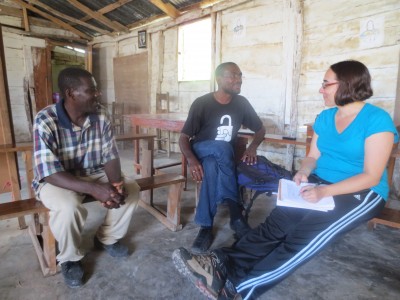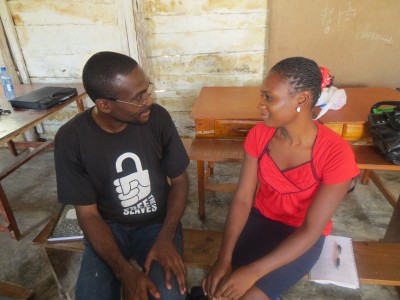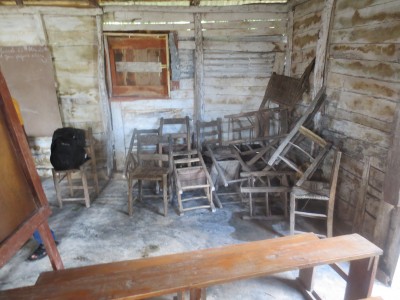Editor’s note: FTS Programs Director Karen Stauss rode out Hurricane Sandy last week while working in Haiti.
I just drove past these words, painted haphazardly in French onto the side of a whitewashed wall:
“Together let’s build Haiti. And rebuild it.”
Was that irony? Or just a plain acknowledgement that this gorgeous island country repeatedly suffers knockouts that require it to clamber back to its feet?
The first time I was here, in October 2010, was soon after I’d started working at Free the Slaves. The guesthouse where we stay in Port-au-Prince was full to breaking point, primarily with Americans who had come to provide what relief they could after the devastating earthquake that hit in January of that year – nurses, builders, experts in agriculture, and others who simply had willing hands. Today, I am the only person occupying my 10-bunk bedroom.
The change has made me think again about what rich countries, and our willing hands, accomplished then. Not just in 2010, but throughout Haiti’s repeated setbacks over decades of political instability and natural disaster.

FTS Programs Director Karen Stauss (right) and Haiti Coordinator Smith Maxime (center) meet a man who just put his son back in school after missing seven years of education.
Our core belief at Free the Slaves is that people everywhere have the strength to solve their own problems, when they organize to support one another and when they unleash their own creativity.
Outsiders are not always well-meaning – but even when we are, we often muck things up because the truth is, we often don’t really know what we’re doing.
This lesson has been learned by many major development institutions, but unfortunately not by all. For FTS, the lesson is to use our own resources in the most effective way we know how, in order to meet communities halfway.
Yesterday, I visited a community in Haiti where our U.S. State Department-supported program just started to work late last year. We began with a house-to-house survey, conducted by the community itself, to find out directly from them the details of their social and economic conditions, with a particular focus on children.

FTS Haiti Coordinator Smith Maxime speaks with community survey team member
FTS works closely with a grassroots organization, Fondasyon Limyè Lavi, bringing tools to mobilize communities around children’s right to be free from domestic servitude and other forms of abuse. We help open up discussions, but they tell us whether it’s a problem for them, and then they decide whether it’s a problem they want to solve. If it is, we help them organize to do it, but again, they come up with the solutions themselves.
Most of the time, a good part of the solution is simple. Parents alerting other parents to the dangers of sending their children away to find a “better life.” Parents deciding they’ll retrieve the children they haven’t seen in years, or at least start to check up on them regularly. Or parents deciding they won’t send their own kids away in the first place. People feeling supported, rather than stigmatized, if they intervene to stop a neighbor abusing a child. Making these norm changes is close to cost-free.
But meeting kids’ rights, like the right to education, costs something. When parents decide they want to protect their children from domestic servitude and other abusive child labor practices, putting them in school is part of the solution.
This process of meeting communities halfway was made a visible reality for me when I saw chairs piled up in the corner of a one-room school yesterday, on a Saturday. Free the Slaves supports teacher salaries for accelerated education, but the kids had to bring their own chairs at the beginning of the school year this month.
 Each chair represents a child coming back to school after having been forced to abandon their studies early on. For some, it might seem sad that students have to bring their own chairs. But the story of those chairs reminds me of what we’re doing here.
Each chair represents a child coming back to school after having been forced to abandon their studies early on. For some, it might seem sad that students have to bring their own chairs. But the story of those chairs reminds me of what we’re doing here.
We can bring what we’ve learned in other places, about the power of the most downtrodden people to create change. We can share strategies as they brainstorm. We can support them with tools to prevent individual tragedies in children’s lives. In other words, we support them when they’ve set their own minds, hearts, skills and hands to protect something and to build something.
Because build they must. The disasters keep coming. Last week, Sandy merely sideswiped Haiti as it beat a trail for the eastern U.S. From where I sat in a comfortable house on the southeastern coast of Haiti, three days of heavy rains and power outages only felt like an inconvenience.
But for a country with missing or degraded infrastructure, eroded hillsides, and lots of shoddy homes, it was a disaster. At our indefatigable partner organization Fondasyon Limyè Lavi, one staff member lost an aunt and four cousins in a landslide in a rural area. The wife of another staff member had her leg fractured when a wall collapsed on her.
Parts of the country are cut off from the rest while they wait for waters on shallow rivers to subside, just enough so that they can once again walk across the rivers without getting swept away by the current. And we were delayed on the drive back to Port-au-Prince this morning because an angry blaze of tires was burning in the middle of the national road – a frequent sign of protest in Haiti. The complaint this time? A truck had just tried to make its precarious way across a partially collapsed bridge nearby and had fallen off, apparently killing some foot travelers who had hopped aboard the trailer to get across.
It’s understandable that you may be tired of hearing about the litany of horrors in places like Haiti. I certainly am. I assume Haitian people are. It’s especially tiresome when we don’t think we can do anything about the problems. That’s why I am so happy that there is something we can do, and that I get to see it taking hold.
